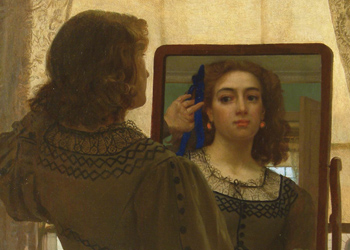Beyond the Mirror

The curator’s choices
By Maria Rosa Figueiredo
Mrs Russell and Son
George Romney
This perfectly illustrates the role of the mirror in displaying an awareness of the “I”. In this phase of self-recognition, the children are not alone in front of the mirror but rather accompanied by their mother who helps them understand their own identity.
According to the account by Henry Russell (the child depicted in this painting), the commission emerged on the day when the artist witnessed, in the Russell family home, the scene of the boy playing with the mirror, spurred on by his mother, who would have exclaimed: “now this would make a good painting”. The work was ready on 27 May 1787, the day when the boy turned four. George Romney was one of the most prolific and successful artists in the British society of the 18th century and having left behind a legacy of around 2,000 paintings and 5,000 sketches spread across 23 countries.
A Girl with a Mirror, Allegory of Profane Love
Paulus Moreelse
The Moreelse work displays a girl with a high social status, with her neck and breast provocatively exposed, pouting and pointing at her image reflected in a mirror in the form of an invitation to share the pleasure that she herself feels on contemplating her youth and beauty. This allegory gets highlighted both by the painting on the wall that depicts an amorous episode from Metamorphoses by Ovid, and by a book illustrated with a woman kneeling before an image of Venus, the goddess of profane love. Moreelse was born and worked in Utrecht and stood out above all as a portrait painter, receiving commissions from all across the country.
The Bunch of Blue Ribbons
Sir Edward John Poynter
In fact, the mirror has always been associated with the feminine toilette and the desire to improve one’s appearance, to protect oneself and to please the “other”. As far back as classical antiquity, we find the theme frequently depicted in paintings featuring characters such as the goddesses of Olympus. Later, Gentile Bellini (c. 1430-1516) became the first known artist to represent a human female in front of a mirror without any other intention than to contribute towards highlighting her beauty. However, it was as from the 17th century, in Holland and in France, when this theme rose to prominence: the woman, sat in front of her dresser, is surrounded by all of the different objects necessary for her makeup. This is the case for one of the first works exhibited by Poynter at the Royal Academy at the beginning of a career that would both prove so highly prolific and end in his becoming president of that institution. The Bunch of Blue Ribbons dates to 1864, the year when his contemporary, Whistler, painted Symphony in White, no. 2: The Little White Girl, a work that also features in this exhibition. As in the painting by Whistler, the face of the girl painted by Poynter does not seem to correspond to the mirrored image as if the artist sought to apply the mirror not only as a reflection but also as a means of showing a different face, portraying the figure in a backlight and illuminating the entire reflection in the mirror.
Self-portrait
Arpad Szènes
This self-portrait by Arpad Szènes represents a mysterious painting included within the scope of the exhibition “Truth and lies within the reflection” that focused on the inaccuracies, the deviations and deceptions in mirrored reflections.
In 1924, Arpad decided to abandon his city of birth, Budapest, and embark on a long voyage that would eventually lead him to Paris where he established his home in 1925. In 1928, he met Maria Helena Vieira da Silva who he would marry in 1930. Henceforth, he undertook numerous portraits of the woman artist. In this self-portrait, as is the case with other paintings portraying Vieira da Silva in his atelier, we may note the symbiosis between the two beings. This is a symbolical self-portrait, in which his own head is portrayed by the mirror, partially occupied by the woman who takes up his thoughts.
Portrait of D. José Pessanha
Columbano Bordalo Pinheiro
In the section dedicated to the mirrored reflections of men, above all used in self-portraits, we have chosen the Portrait of D. José Pessanha by Columbano Bordalo Pinheiro, one of the greatest geniuses of Portuguese painting around the turn of the 19th to the 20th centuries. In this work, a wall mirror serves for the artist to include himself in the picture, complete with palette in hand, while painting José Pessanha. In addition to the intimacy, the painting features various points of interest that get reflected in the surface of the work, gaining autonomy thanks to the chromatic unity of the background.
Beyond the mirror
26 October 2017 through 5 February 2018
Main building – Temporary exhibitions gallery
